
- Dec 04, 2021
- Category: Technographics Data
Are you looking to elevate your marketing efforts enough to yield a massive upsurge in ROI? Well, time to leverage your B2B data to its full potential.
B2B data is the foundation for successfully marketing to global prospects in your field of expertise.
But, why must organizations necessarily use B2B data, irrespective of size?
To offer clarity on the importance of B2B data, here is a list of questions that are answered in this blog:
Well, read on to find out!
What is B2B data?
B2B data, generally referred to as Business to business data, are data sets of company information used to drive marketing campaigns, new sales tactics, improve lead generation, increase business prospects, and perform more effective market research, among other things.
Entering a marketing pitch without being backed by accurate B2B data is only going to leave you at a disadvantage.
The literal definition of B2B data goes something like “Information, particularly facts or numbers, gathered to be studied, considered, and used to aid decision-making, or information in digital format that may be saved and utilized by a computer.”
As the level of marketing difficulty keeps seeing steady growth, leveraging B2B data has become a necessity. In fact, about 77% of B2B buyers complained that deals have gotten overly complicated.
In order to effectively leverage the power of B2B data, you must first understand what it comprises of.
What are the various constituents of B2B Data?
Now that you have a rudimentary understanding of what B2B data is and how it can impact business processes, let’s take a look at what information it packs.
In essence, B2B data encompasses specific data points, and there are essentially six that have been standardized. Both marketing and sales teams must be aware of this, and data collection must revolve around these standard data points.
They are as follows:
- First name
- Last name
- Company name
- Job title
- Business email address
- Business telephone number
Should any of these data points be missing, B2B lead generation will encounter impedance. Apart from these particular contact fields, some other fields you should definitely house in your data repository like:
- Work Experience
- Area of Specialization
- Industry
- NAICS Code
- SIC Code
- Entity Type
- Ownership Type
- Company Size
- Company Revenue
- Company Website
- Assets Size
- Postal Address
- Geographical Location
- Demographics
- Technographics
- Firmographics
Make sure you fill out each individual contact field, paving the way for seamless multi-channel marketing communication with the prospect.
In fact, with robust lead generation techniques and accurate B2B data, you can successfully retain up to 89% of the client base with effortless multi-channel marketing efforts!
What are the different types of B2B data?
With 66% of B2B marketers planning to expand their marketing budget, the current market landscape is going to undergo a radical shift. In order to cope with this change in marketing ideals, you need to break down B2B data and collate an understanding of its various classifications.
To give you a better idea, Here are the types of B2B data:
- Demographic Data
- Firmographic Data
- Chronographic Data
- Technographic Data
- Intent Data
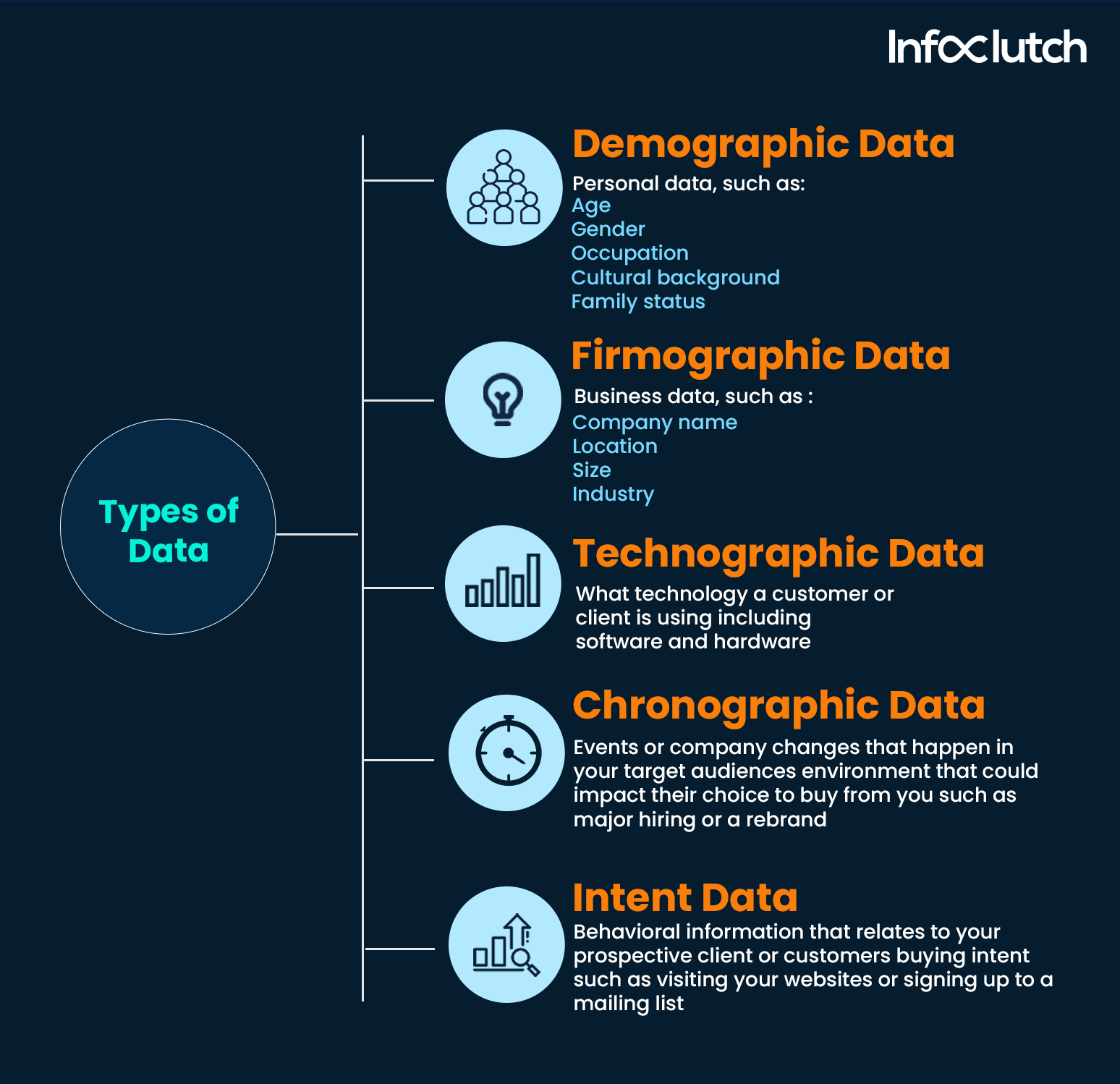
1. Demographic Data
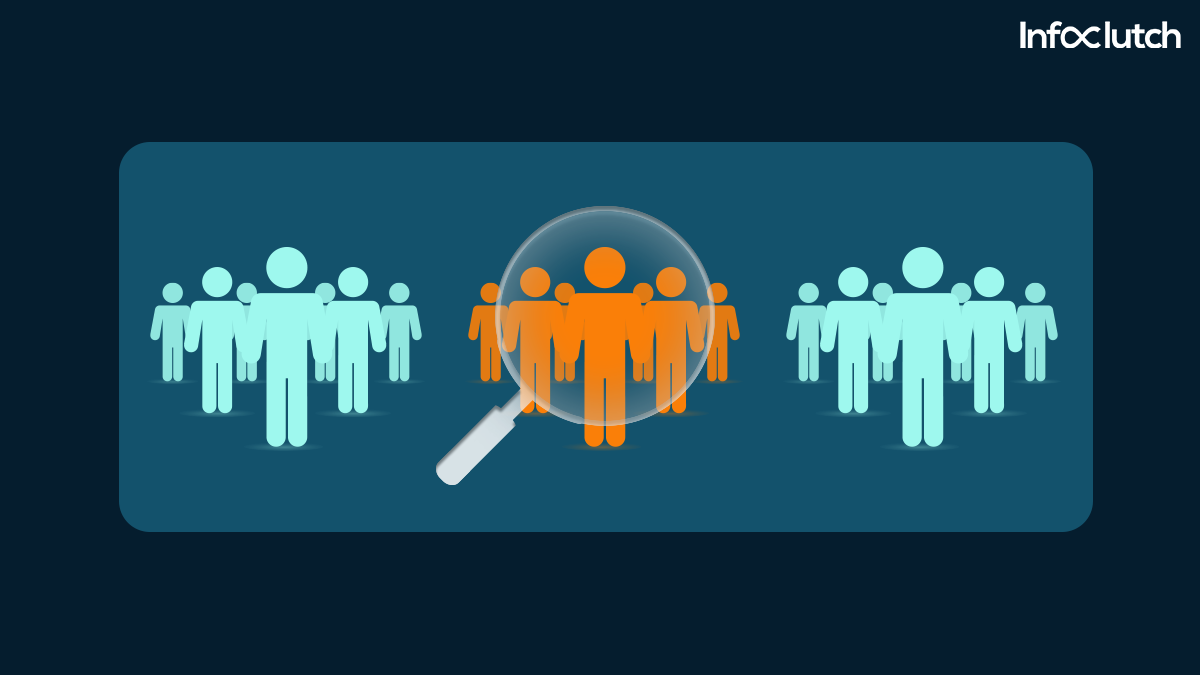
The demographic B2B data is all about enabling you to get your foot through the door by helping you to know your audience truly. This data offers information across the following Contact fields:
- Names
- Phone numbers, email addresses, and other corresponding contact information
- Residential address
- Updated employment records
- An inventory of skills, qualifications, and education
Additionally, you can access information regarding income and other socio-political aspects. You can use demographic data to create highly effective buyer personas.
2. Firmographic Data
The clue is right there in the name. In essence, firmographic data essentially offers information revolving around the specifics of the prospect’s organization/firm.
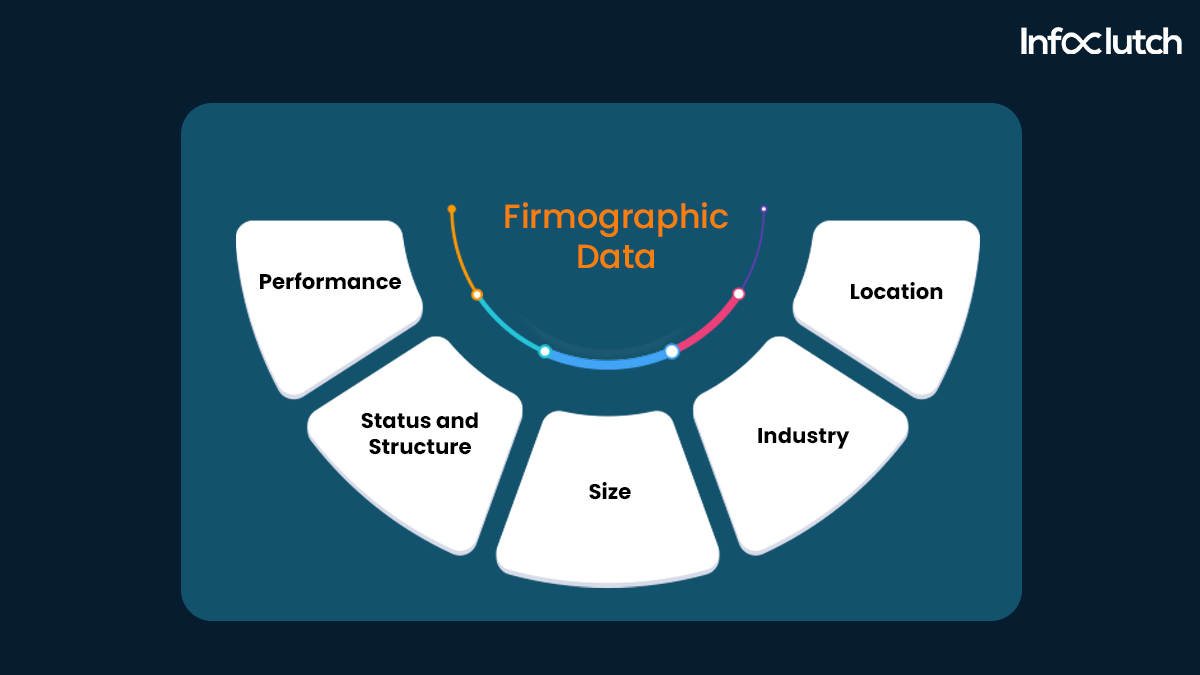
- The name and revenue of the business
- The location of the business
- The industry that the company operates out of
- The business size and number of employees
- The business types
Often, such data can prove invaluable in designing successful lead-scoring processes.
3. Chronographic Data
While you won’t essentially find this B2B data type in most B2B email lists, this data can equip you with extra knowledge – one that firmographic data cannot provide.
Chronographic data includes information such as changes in:
- Company location
- Funding, acquisition
- IPO
- Event appearances
- Job hiring, and so on.
Similarly, you can also uncover details related to:
- The company’s hiring processes and trends
- The company funding
- Where do the funds come from?
- Acquisition history
By utilizing chronographic data, you can easily give your marketing campaigns a sharp, competitive edge.
4. Technographic Data

Technographic data is primarily concerned with the tools and technologies that businesses use in their day-to-day operations. Specific data fields would include information related to:
- Features
- Integrations
- Technologies (Hardware and Software)
- Specific tools
There are two types of technographic data – pure and social – that you can use depending on your needs.
In 2019, companies worldwide spent a whopping $2 trillion on digital enhancement processes. Given the growing need for technographic data, more and more B2B data services have begun to expand their scope of services to include the same.
5. Intent Data
B2B intent data leans toward the purchase and buying activities of a firm. Essentially, intent data is a deep dive into how your prospect thinks, in turn, figuring out how they expect you to approach them.
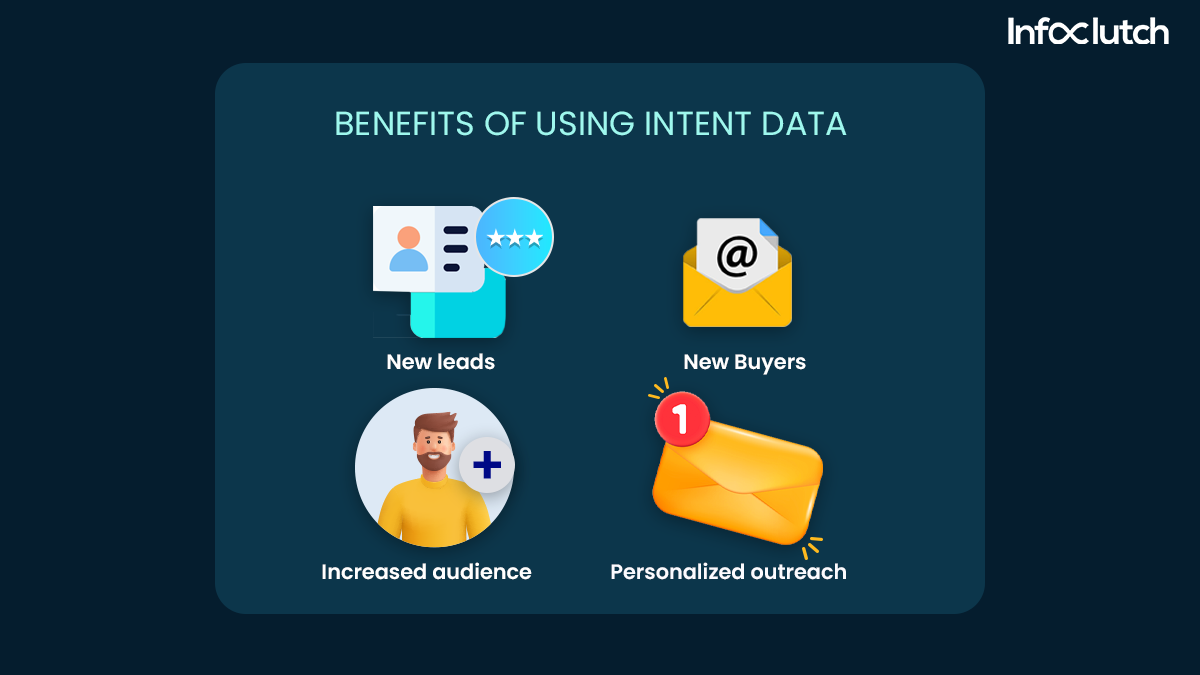
Here’s what intent data fields contain information about:
- A log of the company’s website visits and the time spent
- Buying-related search history
- An inventory of the services the company subscribes to
- Data regarding the products they view
In order to make the most of intent data, it would be best to adopt business data visualization practices.
A few must-knows about B2B data quality!
Appending and adding contact information to your list are not the only practices needed to maintain B2B data health. Continual data updating and verification is equally important, since any sign of data redundancy can bring down the repository health significantly.
Part and parcel of riding the B2B data wave is also maintaining its integrity. Stale data is of no use and, in turn, will result in additional wastage of resources and time.
Your marketing efforts may be jeopardized if you are ignorant of data redundancy.. To begin, because this indicates data recurrence, data redundancy comprises identical data being available in numerous formats or tables.
As a result, data analysis becomes meaningless and biased, and you can no longer utilize the information you have to execute data-driven decisions.
Since the business landscape is so volatile, data redundancy is inevitable. It is vital to keep an eye on your database and conduct verification and appending operations per industry standards.
1. Getting rid of redundancy
Let’s understand data redundancy with a straightforward example. For instance, corporations may keep personnel files in the HR department; however, the same data may be duplicated in the local office.
Aside from untrustworthy, irregular corporate-wide datasets, data redundancy can easily result in data corruption. Hence, to avoid this issue entirely, here are a few steps to avert/get rid of any signs of redundancy in the current state of your data repository:
- Periodic database checks
- Identifying the root cause for redundancy
- Data integration (Integration of all organization-wide datasets into a single massive data repository)
- Better database design
- Clean your database as per industry standard, and so on!
2. Data updating, verification, and storage
Businesses should validate their datasets in addition to cleansing them. The process of ensuring the precision of your datasets is known as data validation.
Following data purification, this comprises evaluating data for significance and consistency using predefined validation standards and constraints.
Consequently, keep updating and appending contact information in your database, making sure all the contact fields are populated for every prospect.
3. Data blending
Clearly, data redundancy is one of the factors bringing down the efficacy of your B2B data. One of the most popular solutions to this issue is a phenomenon called data blending. Unlike data integration, data blending entails bringing together relevant information from varied yet specific data sets for comprehensive market analysis.
Instead, specific information datasets are created to help you out with specific information.
Here are certain pointers about data blending you should keep in mind:
- The process is a lot less time-consuming than data integration and is quite effective in giving accurate surface-level insights.
- Enables non-technical people to gain quick insights into finance, sales, marketing, and so on
- For instance, you can combine product profitability statistics with data from your CRM system.
- This identifies the most profitable items or services while also showing client purchasing interest.
Where is B2B data sourced from?
Without 100% accurate and well-segmented B2B data to back your marketing campaign up, returns are going to be abysmal. In fact, a certain survey also concludes that 54% of sales agents agree that contacting is a lot harder than it was five years back.
So, B2B data must definitely be sourced from cent-percent reliable and credible sources. Based on the nature of data, they can be split into two types:
- Internal data: Prospect information secured by the respective organization itself.
- Third-party data: Contact information purchased from third-party B2B data vendors.
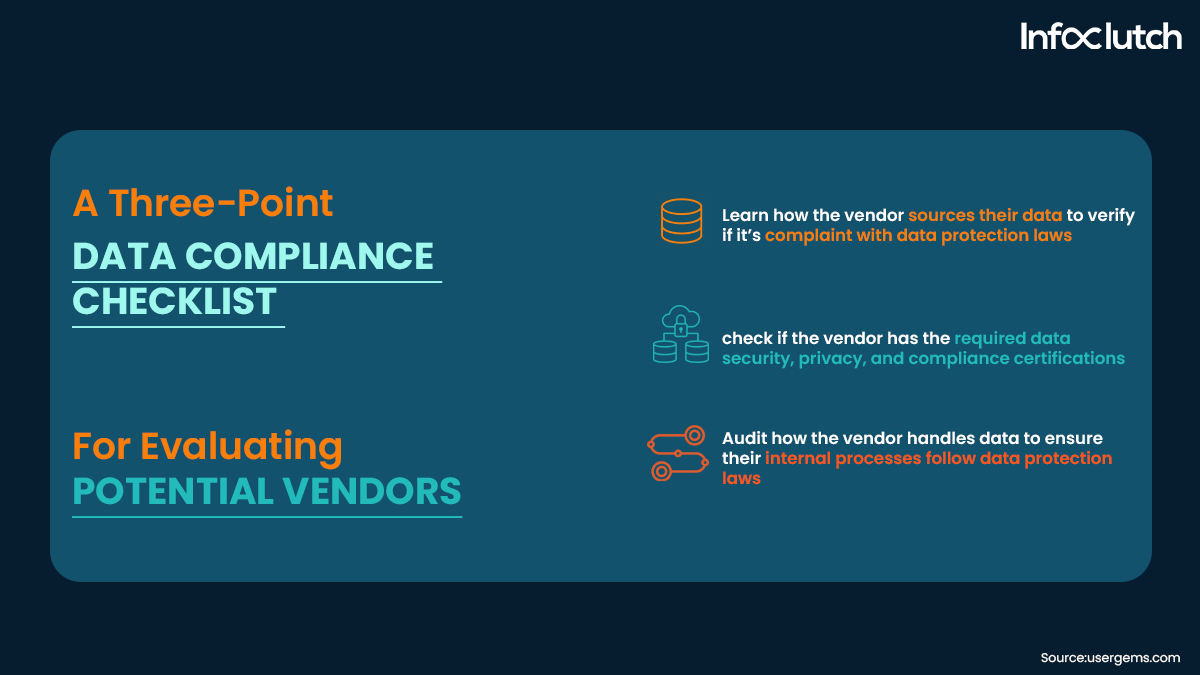
Irrespective of the data type, organizational contact information is generally collated from certain fixed external sources, including:
Business information websites:
These are essential sources of firmographic data. These sites include a wealth of information on firms all across the world, including:
- General business details
- Headcount
- Funding
- Hiring activity, and more.
Companies use this data for a variety of objectives, ranging from investment to market research.
Technographic data sources:
Relevant B2B data regarding the technology stacks being leveraged by your prospects. This information is further used for:
- Market research
- Investment
- Lead generation, etc.
Review websites:
Review platforms can be used to gather feedback about competitors and firms of interest. Analyzing review data allows you to:
- Uncover red flags
- Assess how they treat their employees
- Determine what employees are seeking overall
- Identify other relevant positive or negative signals.
Employee data sources:
These essentially include professional networks that offer abundant B2B talent data, which can further be leveraged to transform:
- Recruitment
- Market analysis
- Power HR tech platforms, and so on.
Other private sources:
Some other private data sources include:
- Financial and market intelligence
- Data-as-a-service (DaaS) providers
- Pay-Walled websites, and so on.
Furthermore, a recent study also revealed up to 6-10 professionals are generally involved in the B2B decision-making process. As a result, your business-to-business data repository must be 100% accurate so as to enable accurate lead generation.
With the right insights in the palm of your hand, you can approach any organization’s purchase team and offer them true value.
Tips for collating accurate B2B data
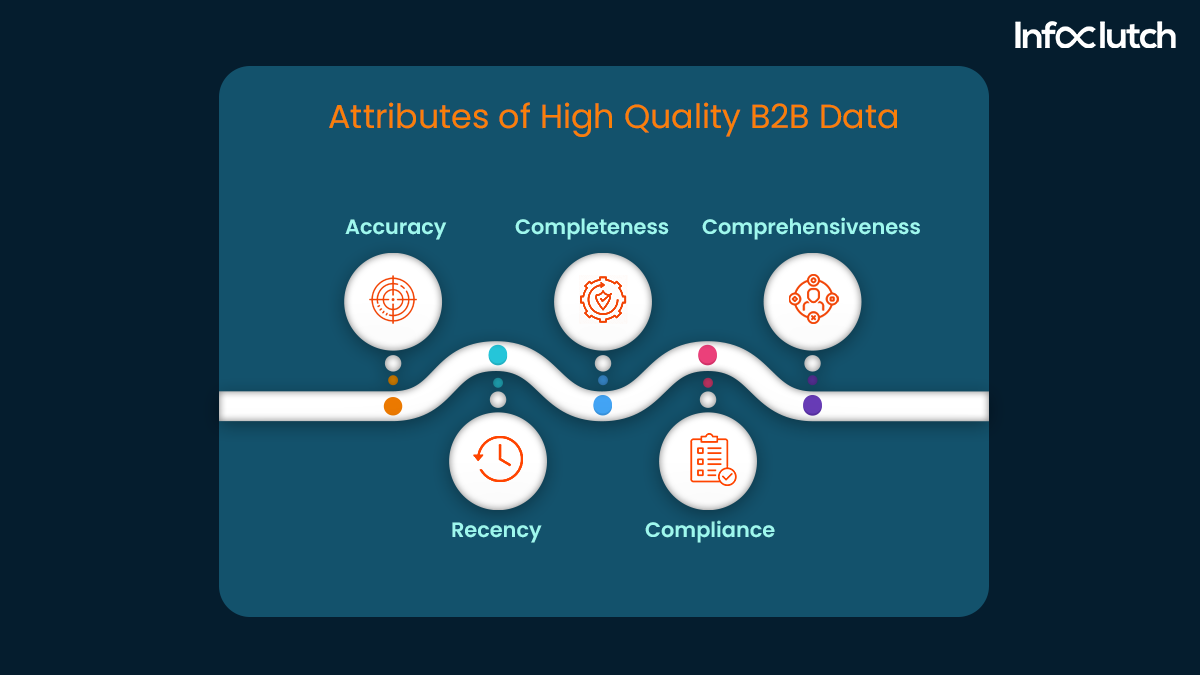
To further help you on your path to sourcing authentic B2B data, here are a few pointers that might come in handy:
- Look for info that’s accurate: Make sure you can acquire reliable and complete information before basing a whole data strategy on it.
- Make certain that the data you’re using is relevant: Even the most comprehensive dataset may prove inefficient for your organization if the redundancy is not removed. Every stage of the process of working with vast volumes of irrelevant data will be expensive and, to put it bluntly, ineffective.
- Check that the data you’re utilizing is clean One of the most important data quality dimensions is data freshness. It’s also a fairly typical criterion that plays a significant role in selecting a data provider since it demonstrates the company’s technological ability.
- Concentrate on the knowledge: Provide practical training/knowledge to every data collector to emphasize the importance of proper data collection techniques. Make sure that someone experienced in data gathering is in charge of monitoring the process.
The most notable use cases of Business-to-business data!
The B2B e-commerce market is absolutely booming and is growing with a staggering 19.7% CAGR. As a result, the industry will be valued at USD 33,317.33 Billion by the end of 2030. With that being said, the importance of B2B data is being realized and product marketers in US reported that 7.78% of their organizational revenue spent on marketing.
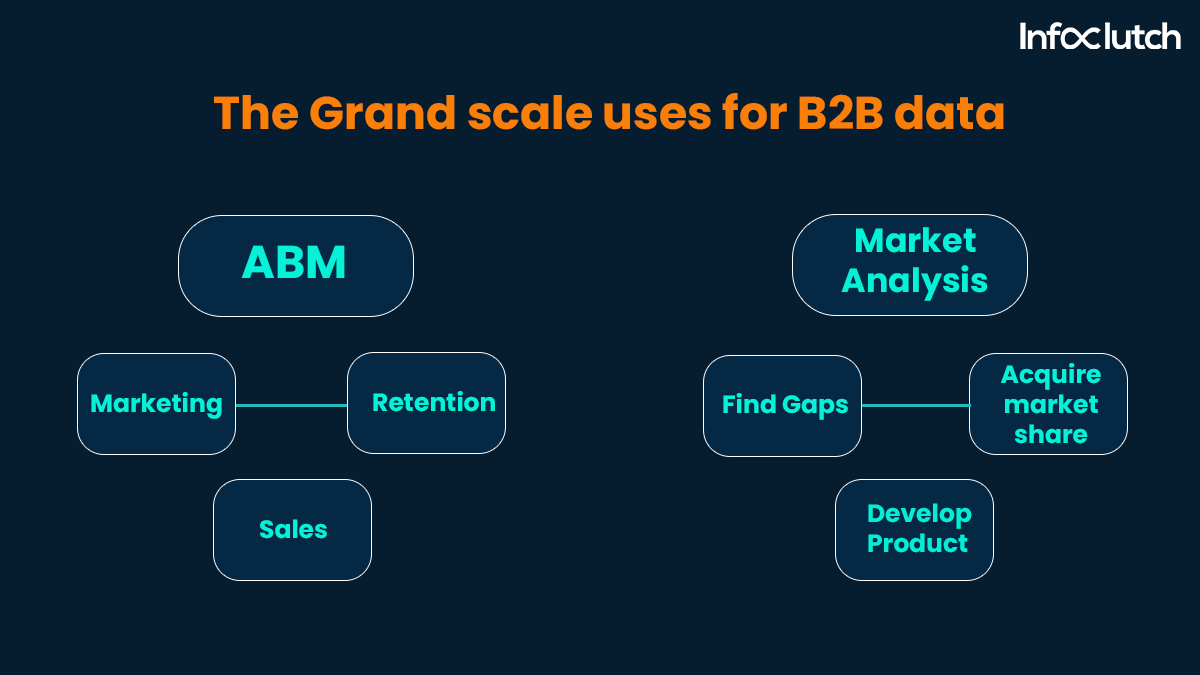
So, what are some of the top use cases of B2B data? What are its various use cases, and how does it resolve specific organizational pain points?
Well, take a look at the following section to obtain a better idea:
1. Lead generation
Organizations use B2B data to improve their sales and marketing tactics, elevate lead generation quality, and, as a result, enhance conversion rates. For instance, a software business is able to monitor a certain company’s technographic data.
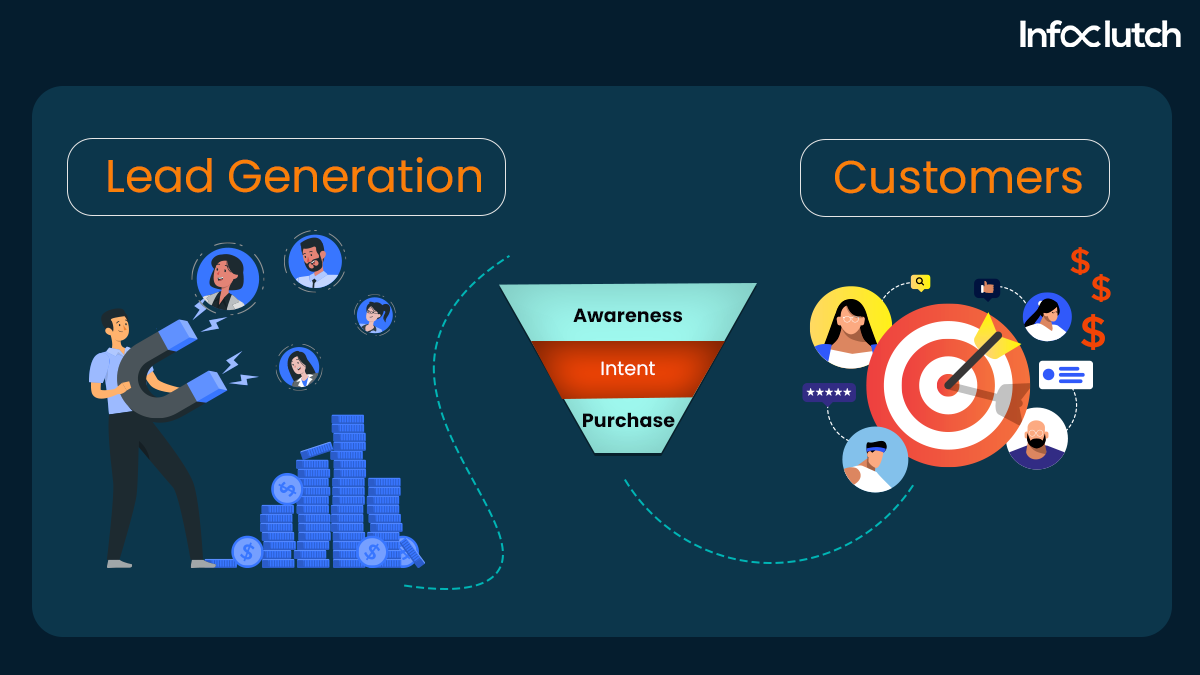
As a result, they may supply their marketing and sales departments with vital insights regarding the prospective customer’s present tech stack and how it can be supplemented with additional software.
2. TAM identification
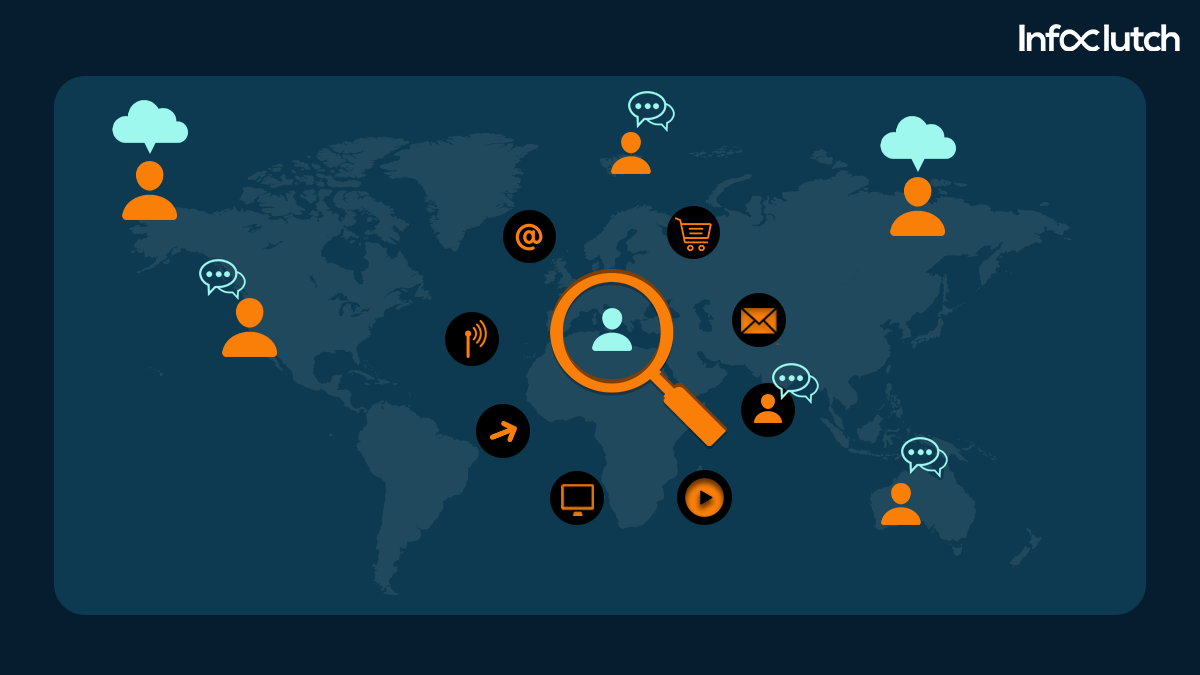
Having accurate B2B data will go a long way in helping you zero in on your TAM (Total Addressable Market). This directly translates to the cumulative amount of prospects currently populating your target market.
3. Outbound sales
Outbound sales occur when a sales team representative approaches the prospect first rather than the other way around. It could be done through email marketing or by dialing phone numbers from your contact lists.
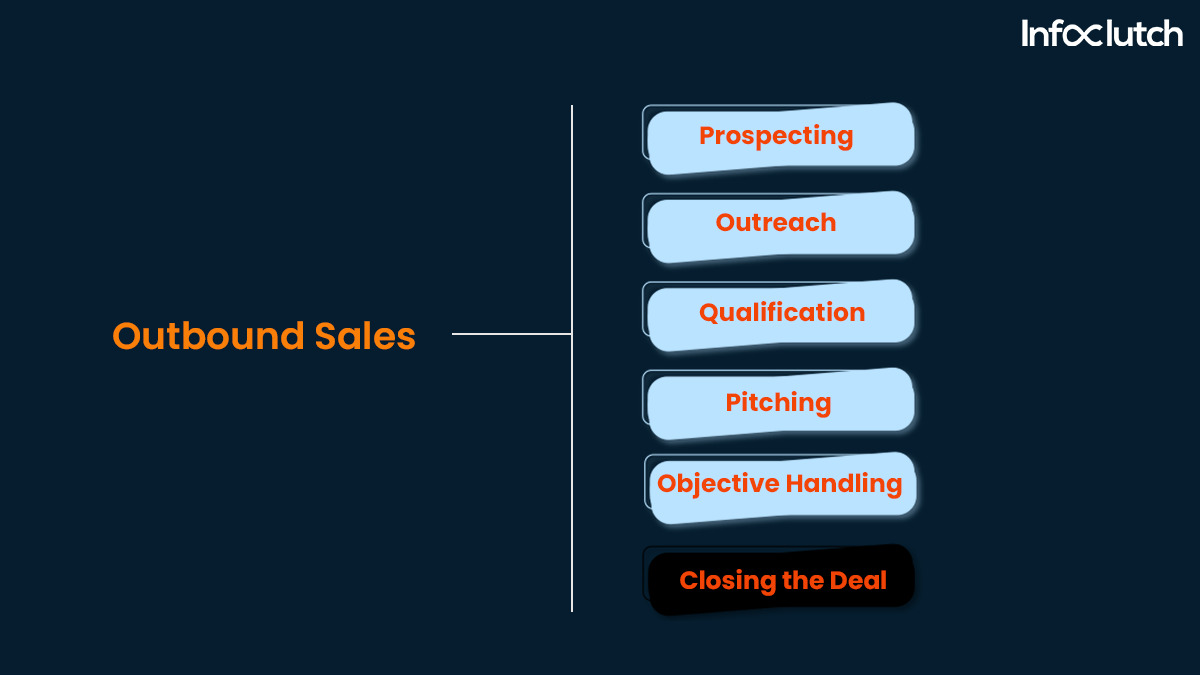
Leveraging B2B data may save time completing deals if you can persuade them, attract qualified leads, and assist them along the sales funnel.
4. ICP determination

ICP stands for Ideal Customer Profile. With aid in lead generation, B2B data will help you shape your ICP accurately. In essence, your ICP entails a detailed depiction of your ideal client, which you can use to locate people who share its traits.
5. Data Analytics
B2B data can aid analytics in three primary sectors, namely: Market growth, competitive analysis, and risk analysis.
An organization, for example, might track its competitors’ technology stack, locations, personnel count, and product purchases to forecast expansion or industry growth.
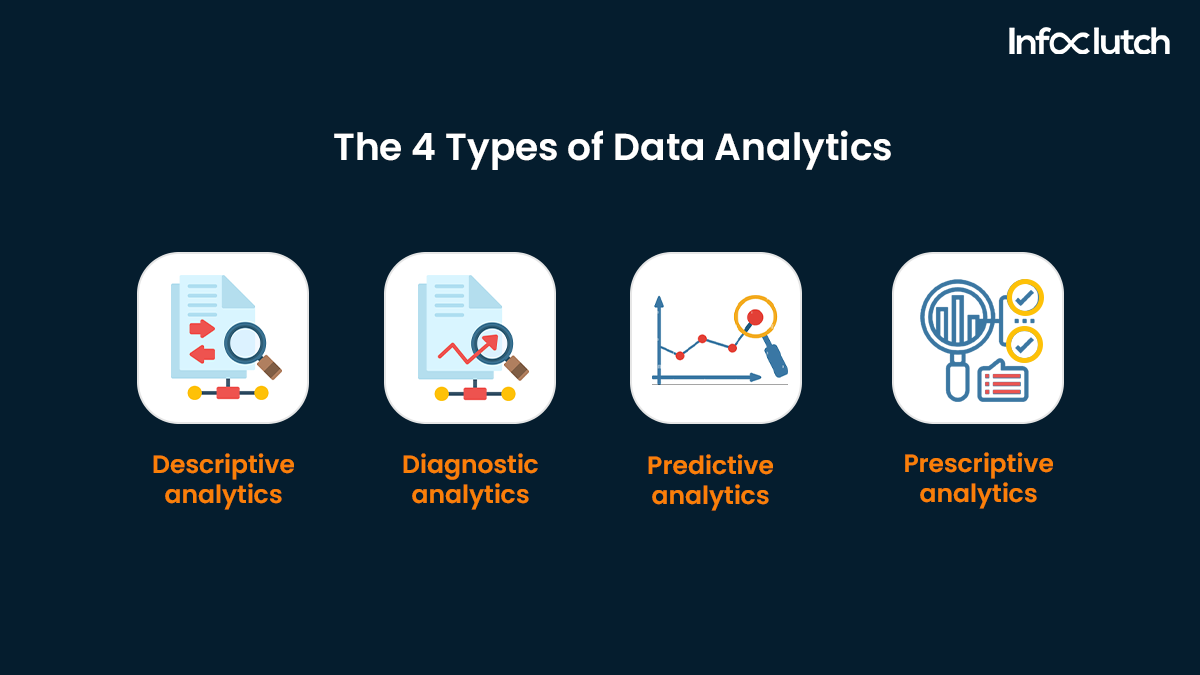
Some other notable analytics-related use cases of B2B data include:
- Internal process improvement
- Market gap identification
- Monitoring competitors
- Product/service updates
- Keep an eye on market growth, and so on!
B2B Data Services Offered By InfoClutch
Now that you know the essence of B2B data in your daily marketing operations, you can leverage various tactics to get a hold of genuine contacts from all over the world. However, you will still end up utilizing a considerable chunk of time and resources doing this.
Instead, you can simply opt for the professional data aggregation and list collation services offered by InfoClutch to avail of verified B2B contacts.
Here is a quick run-down of our services to give you a better perspective:
- Customizable email and mailing list creation: Formulation of a contact list based on your custom choices and marketing campaign requirements.
- CRM enrichment: We capture, analyze and enrich CRM data to deliver best-in-class results that improve the effectiveness of your marketing campaign.
- Data appending: Updates your repository with new data.
- Data licensing services: Data licensing refers to a legal agreement between the owner of the data and the business. Data licensing allows businesses to use data without the fear of legal ramifications.
- Tele- and email verification: 1M+ emails and 4M+ calls were conducted to verify the activeness of contacts.
- Double verification for data: All data is re-verified before being packaged and sent out to clients.
Wrapping Up
Overall, B2B data has proved beneficial for businesses in increasing prospects, strengthening market research, improving lead creation, better aligning sales and marketing tactics, and more.
As the workforce becomes more digital, firms will turn to business-to-business data to establish relationships with other businesses and maintain their ROI.
Now that you understand the importance of B2B data in your daily business operations, it is also vital to keep in mind their efficacy. You have to keep updating and, thus, cleaning your database periodically to maintain data health.
Should you not want to experience the hassle of collating all this B2B data yourself, you can always rely on verified third-party data aggregators like InfoClutch. Post a swift understanding of your niche marketing requirements; we provide a customizable email list option for all your contact data needs!
So, get in touch with us today and avail of your copy of verified B2B contact list now!
F.A.Q.s
1. What is an example of B2B data?
B2B data essentially refers to any piece of information that can be leveraged to get in touch with the right prospects and ensue positive engagement. This includes contact fields such as phone numbers, job title, company name, and so on!
2. What are the various benefits of leveraging accurate B2B data?
The numerous advantages that entail the utilization of B2B data include: ·
- Seamless communication with ideal prospects
- Indulge in data-driven business decisions
- Pave the way for efficient email marketing
- Enable ROI upsurge with robust lead generation
3. What Is a B2B Data Provider?
A third-party B2B data vendor, who either offers marketing B2B data as a DaaS (Data-as-a-service) or pre-packaged data, is referred to as a B2B data provider.
4. How do you collect B2B data?
B2B data can be collected from a variety of credible sources, including:
- Business Directories
- Government Directories
- Reputed journals
- Opt-in emails
- Public databases, etc.
